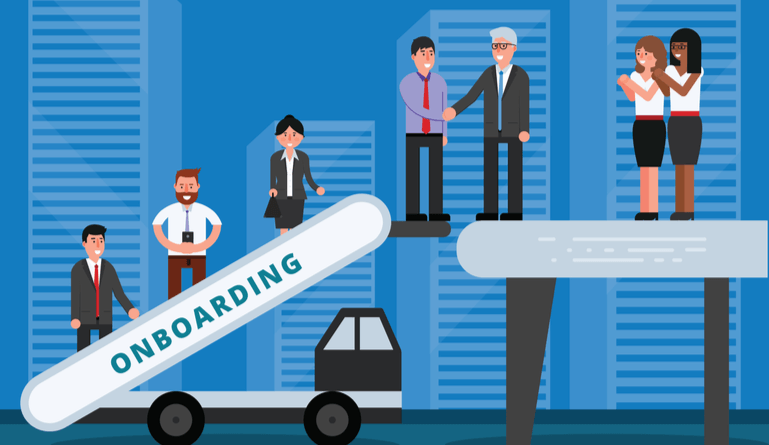Employee onboarding is the key to retention.
A set of good sustainable onboarding practices can help you achieve long-term, loyal, and dedicated employees. Employees now know what to look forward to. The value of retention has increased over the years; employees usually turn over when they feel the workplace environment and onboarding practices are not good enough.
Companies spend hours interviewing with best-suited candidates but what is it worth if your employee won’t even spend a month or two in your organization? According to Equifax(1), most employees leave their jobs voluntarily within the first few months of employment.
But how could a company ensure employee retention? Well, the answer is simple, a set of sustainable onboarding practices. Let’s now talk about what onboarding practices are, why it is important and how it can be implemented.
What Is Employee Onboarding?
Employee onboarding is the process of enlightening a new employee with your company’s rules, regulations, policies, employee roles, duties, and the culture of your company. It is a program where all new employees are taught about workplace ethics, culture, and responsibilities.
Most companies give their new employees a tour of the office or a small orientation; this way the employee does not know much about the company and its policies, hence will not participate much in the workplace.
A proper employee onboarding will not only make the employee feel welcomed but will also ensure employee retention.
What Is Employee Onboarding Important?
If employees are made clear about their duties and regulations of the workplace before beginning the job journey, it helps them work accordingly and produce the desired output. It enhances employee satisfaction, engagement, retention, and performance.
Here are some facts proving employee onboarding importance:
- More than 75%(2) of the employees prioritize socialization.
- A structured onboarding program ensures a life of 3 years with an organization for 69%(3) of the employees.
- Many employees(4) claimed that they left a job because of poor onboarding programs.
Importance Of Employee Onboarding Practices
- Reduces chances of employee turnover.
- Increases employee engagement and job satisfaction.
- Helps in building a strong company structure.
- Increases employee productivity.
- Enhances employee experience.
Employee Onboarding Best Practices
-
Planning An Onboarding Practices Checklist
Each employee is differently capable and has a different way of working. However, there are certain areas where all the new hires struggle and there are things they need to cover. This could be anything from administrative tasks to setting tech devices to filling out benefit forms.
A proper onboarding checklist will help you (the recruiter) be ready for any queries from the employee along with making sure the employee is well prepared for future work.
-
Prior Conversation with Employees
Communication is the key to a healthy workplace environment especially while hiring new candidates. Always keep new employees in the loop even before the start date. Give them insights about dress code, workplace ethics, transport options, and what they need to bring with them on their first day.
This will guarantee that your recently added team member knows you’re on top of their onboarding program.
-
Onboarding Program Even After Hiring
Onboarding practices should not stop right after recruitment. Once the employee has started working, make sure you still check up on them and ensure that they are handling the work well. Doing so makes the employee feel respected.
The easier an organization makes a workplace for an employee, the better will be the employee retention.
-
Make New Hire’s First Day Memorable
The first impression is the last impression.
A term we have always heard all our lives. Likewise, for an employee, your company’s first reaction will decide whether he wants to work or will quit the job after some time. Here is how you can have a good first impression:
- Planning and setting up their workstation with welcoming ideas such as a welcome good luck note.
- Helping them to socialize with other employees and staff members.
- Setting up a lunchtime on their first day with the other staff members to increase interaction.
- Showing them previous videos of annual meetings or any fun times all the employees had.
-
Job Training Programs
Another approach to employee onboarding is setting up seminars, workshops, or job training programs to achieve short-term goals.
To assist them with the workload and handling the pressure, a well-structured onboarding program will act as a feature of their employee onboarding. Make them work on errands they’ll be relied upon to finish while offering help where required. This way they will learn quicker and adapt to the work environment easily.
-
Let Them Do Their Own Work Station
Employees love freedom. If they are given some edge, they would mix together among the company quickly and easily. One way to do so is by letting them design their own workstation.
Employees spend most of their time on their desks and a good workstation will surely add to their speed and productivity. They will have the freedom to choose what, how, and where to keep their things.
-
Unique Onboarding Gifts
When you hire new candidates, make sure to hand over an onboarding kit to them. This way they will not only remember this act as a good welcoming gesture but also as a way to return the gesture they would work much more efficiently.
Here are a few onboarding gifts ideas:
- A water bottle with your company’s logo or employee’s name on it.
- A durable backpack with your company’s logo or employee’s name on it.
- A power bank.
- Notebooks.
- Coffee mug with your company’s logo or employee’s name on it.
-
Enlighten New Hires About Company’s Culture
A very important aspect of employee onboarding practices is providing the new hire with required information about your company’s culture. This will help them understand your company’s objectives, mission, vision, and goal; so they can contribute equally towards the growth of the company.
This should include everything from business aims to your target audiences to how you deal with your customers.
-
Team Bonds
A good workplace is one where everyone works in harmony and towards the same goal. When a new hire enters a group of teams, he is most likely to feel like an outsider. However, to make him participate and contribute, make sure you create team bonds before starting off with the teamwork.
Team bonds are developed better in relaxed environments. For instance, making teams sit together for lunch will make the communication casual and easier for the newcomer.
It’s additionally an incredible method to slip somebody into another gathering of individuals, furthermore, it likewise offers a break from the working environment setting for the group which evens the odds for everybody concerned.
Conclusion
Employee onboarding programs increased retention by 25% along with improving employee performance by 11%.
Ensure that your onboarding plan proceeds to develop and advance after some time. You’ll get input from recruits and will consistently be rolling out little improvements to your representative onboarding measure. It’s a mutual benefit for both you and your new workers.
The significant thing to recall is to learn constantly. Make sure you keep on upgrading your onboarding programs so you can keep your employees in the loop and make improvements in any areas they are struggling with.
A well-thought employee onboarding program can provide your company with the best, loyal, and long-term talents.








